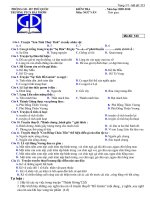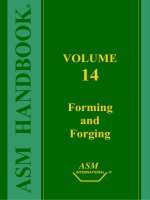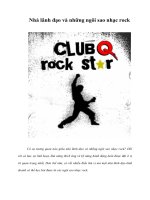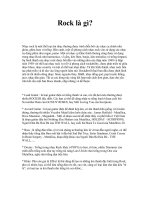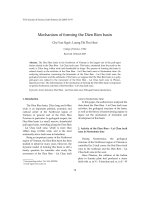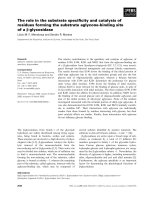Rock forming minerals
Bạn đang xem bản rút gọn của tài liệu. Xem và tải ngay bản đầy đủ của tài liệu tại đây (750.44 KB, 22 trang )
How to Know Minerals
Chapter 4 Earth Science Book
read pages 46-57
restate & answer Topic Questions 1-9
practice the 30 lab mineral samples
Topic 1:
Page 47 Earth Textbook
Rock-Forming Minerals
common minerals that make up the Earth’s crust
* over 2000 minerals known
* most are silicates (Si + O + metals)
* not always large crystals
* mineralogy is the study of minerals
and their properties
Topic 2:
Page 47-48 Earth Textbook
Identification by
Inspection
simple observations made by looking
*Color
*Luster
*Crystal System (shape)
Topic 2:
Page 47 Earth Textbook
Color
* first, most easily observed
* least useful when identifying minerals
1. impurities change mineral’s colors
2. mineral’s colors are similar
3. colors change/react in air
Topic 2:
Page 47 Earth Textbook
Luster
the way a mineral shines
* Metallic Luster
* Nonmetallic Luster
Topic 2:
Page 47 Earth Textbook
Metallic Luster
*shines like polished metal
*(galena, pyrite, chalcopyrite)
Topic 2:
Page 47-48 Earth Textbook
Nonmetallic Luster
*vitreous – shining glass (quartz)
*pearly – like a pearl (mica)
*resinous – like wax (sphalerite)
*greasy, oily – (talc & graphite)
*dull, earthy – (kaolinite, limonite)
*brilliant, adamentine – (diamond)
Topic 2:
Page 47-48 Earth Textbook
Crystal System (shape)
*cubic – all 90º, all lengths equal
*orthorhombic – all 90º, no lengths equal
*tetragonal – all 90º, some lengths equal
*triclinic – none @ 90º
*monoclinic – some @ 90º
*hexagonal – 3 axes @ 60º
Topic 3:
Page 48-50 Earth Textbook
Identification by
Simple Tests
*Streak
*Fracture or Cleavage
*Hardness
Topic 3:
Page 48 Earth Textbook
Streak
the color of a mineral’s powder
* rub mineral on unglazed white tile
metallic - streak dark as mineral
nonmetallic - streak colorless to light
Topic 3:
Page 49 Earth Textbook
Cleavage
minerals split along flat surfaces
1 direction – micas, gypsum, talc
2 directions – feldspars, hornblende
3 directions – galena, halite, calcite
Topic 3:
Page 49 Earth Textbook
Fracture
minerals break along non-cleavage surfaces
•concoidal fractures – shell-like fracture
•fiberous or splintery – jagged and sharp
•uneven or irregular – rough surface
Topic 3:
Page 49-50 Earth Textbook
Hardness
minerals resistance to being scratched
*Mohs’ Hardness Scale – page 50 in text
•minerals ranked on a scale of 1 to 10
•need fingernail, copper, steel, glass, topaz
•1 softest (talc), 7 hardest common (quartz)
and 10 is the hardest of all (diamond)
Topic 4:
Page 50 Earth Textbook
Specific Gravity
the ratio of the mass of a mineral to the mass of
an equal volume of water
•specific gravity = mass of sample in air
mass lost in water
•nonmetals - less than 4
•metals - above 5
Topic 5:
Page 51 Earth Textbook
Acid Test
weak acid will release bubbles of CO2
*calcium carbonate fizzes in acid (HCl)
*calcite is calcium carbonate, CaCo3
*dolomite - CaMg(CO3) must be powdered
*malachite & azurite are copper carbonates
*limestone & marble calcite
Topic 6:
Page 51 Earth Textbook
Special Properties
•taste – halite is salty
•magnetic - magnetite
•double diffraction – calcite/Iceland par
splits images into 2
•flourescence – glows under ultraviolet
light, fluorite, sphalerite, willemite
•phosphorescence – glows even after
ultraviolet off
Topic 7:
Page 53-54 Earth Textbook
Silicates
made with silica tetrahedrons (light colored)
a) quartz
b) feldspars: orthoclase, plageoclase
c) micas: muscovite, biotite(black)
d) talc
Topic 7:
Page 54-55 Earth Textbook
Ferromagnesian Silicates
silicates with iron and magnesium (darker)
e) amphiboles: horneblende
f) pyroxenes: augite
g) olivine
h) garnets
i) kaolinite
Topic 8:
Page 55-56 Earth Textbook
Carbonates
made with carbonate group –CO3
*Calcium Carbonates
•calcite(Iceland spar), dolomite
*Copper Carbonates
•malachite, azurite
Topic 9:
Page 56-57 Earth Textbook
Oxides
a metal combines with oxygen
*Iron Oxides
•hematite (reddish-brown streak)
•limonite (yellow-brown streak)
•magnetite
*Aluminum Oxides
•corundum
•bauxite
Topic 9:
Page 56-57 Earth Textbook
Sulfides
a metal combines with sulfur
•galena
•pyrite
•chalcopyrite
•sphalerite
How to Know Minerals
Chapter 4 Earth Science Book
read pages 46-57
restate & answer Topic Questions 1-9
practice the 30 lab mineral samples

